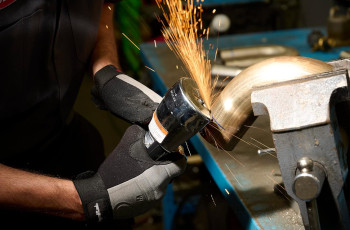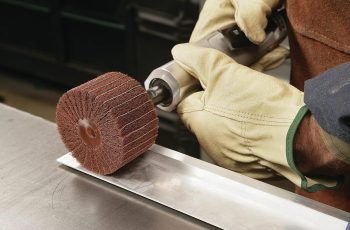When you’re working with die grinding, variable speed can be a game-changer for precision and accuracy. It’s all about how you control the RPM to match the material and task at hand. With the right adjustments, you’ll minimize heat buildup and reduce the chance of mistakes. But how exactly does this impact the quality of your work? Let’s explore how variable speed makes a difference in achieving outstanding results.
Key Takeaways
- Variable speed control allows precise RPM adjustments for different materials, enhancing precision and accuracy in die grinding.
- Lower speeds reduce heat buildup, preserving metal integrity and improving dimensional accuracy.
- Higher RPMs provide lower torque, ideal for fine finishing and detailed work.
- Consistent RPM under load ensures uniform material removal and surface finish.
- Slower wheel rotations minimize friction, reducing vibration and increasing precision.
The Role of RPM in Die Grinding
RPM, or revolutions per minute, plays an essential role in die grinding applications, directly influencing tool performance and precision. By optimizing RPM, you can prevent tool deformation and maintain dimensional accuracy. High RPMs might cause ultra-thin diamond blades to warp, leading to inaccurate cuts. Proper tool selection and RPM settings are vital to avoid uneven thermal expansion that distorts tool geometry. Consider your tool’s geometry—coarse grit tools prefer lower RPMs to minimize overheating, while fine grit tools handle higher RPMs for precision finishes. Matching the right RPM to your tool’s characteristics guarantees you achieve the best material removal rate and surface finish. Ultimately, optimized RPM settings preserve tool integrity and enhance overall grinding efficiency. By maintaining a balance between RPM and cutting speed, you ensure that the machining process remains effective without compromising the quality of the die grinding outcome.
Fine Detail and Intricate Metalwork
When tackling fine detail and intricate metalwork, variable speed control is your best ally for achieving precision and maintaining metal integrity. Precision techniques rely on this feature to make delicate adjustments, preventing damage to intricate designs. By using lower speeds, you reduce heat buildup, which preserves metal integrity and minimizes warping. This fine control is essential for effective burr removal and edge finishing without excessive material removal. Small accessories, like carbide burrs, benefit from tailored precision enabled by adjustable speeds. Furthermore, slower speeds help achieve smoother finishes, reducing the risk of surface discoloration and unintended texture changes. Die grinders are designed for precision, excelling in tasks that require accuracy and control rather than brute force. Maneuvering tight spots becomes more manageable, as controlled speed aids in maintaining stability and precision in confined spaces.
Speed and Dimensional Accuracy
Although variable speed control in die grinders is often overlooked, it plays an important role in achieving dimensional accuracy. By allowing precise speed adjustment, you can tailor RPMs to the material and abrasive, optimizing the removal rate. Dotco and Cleco tools are recognized for their quality and durability, making them an excellent choice for professionals seeking precise performance. Maintaining RPM within maximum ratings prevents premature wear and preserves dimensional fidelity. Torque management is vital, as higher speeds provide lower torque, promoting fine finishing without distortion. However, slower speeds increase torque, useful for roughing but risky for over-grinding. Tools with speed governors guarantee consistent RPM under load, reducing surface irregularities. For tight tolerances, higher RPMs with small abrasives minimize tool chatter. Electric grinders offer more stable speed control, reducing dimensional variability compared to air grinders.
Heat Management in Grinding Operations
While speed control is essential for achieving dimensional accuracy in die grinding, managing heat is equally important to guarantee the integrity of your workpiece. Coolant application plays a significant role in absorbing heat generated by friction between the grinding wheel and the workpiece. By using water-based or oil-based coolants, you can prevent excessive temperature rise and maintain thermal stability. Implementing dedicated cooling systems that combine coolant circulation with airflow helps stabilize temperatures, thereby avoiding thermal damage like distortion and surface integrity loss. Additionally, optimizing grinding parameters such as feed rate, depth of cut, and wheel speed helps manage heat generation. Effective thermal management enhances part quality and tool life, which is crucial in precision grinding operations. Regularly dressing the grinding wheel and using the right abrasives can further minimize heat, ensuring precision and maintaining the workpiece’s quality.
Enhancing Tool and Bit Lifespan
When you’re aiming to enhance the lifespan of your die grinder and bits, finding the ideal RPM is essential. It helps minimize heat-induced wear, which is a common culprit of premature tool failure. By adjusting the speed to suit different materials and tasks, you not only protect your equipment but also maintain efficiency and precision.
Optimal RPM for Longevity
Achieving the ideal RPM for die grinding is essential for enhancing tool and bit lifespan. When you’re considering tool selection, focusing on RPM adjustments is vital. Different tools like diamond and CBN grinding tools need precise RPM to avoid excessive wear. If you run them too fast, you risk thermal degradation, leading to softening or fracturing of particles. Keeping RPM within manufacturer specifications is key. Your typical die grinder operates between 15,000-20,000 RPM, with some going beyond 50,000 for precision tasks. Use variable speed controls to tweak RPM based on material and task requirements. Remember, running at maximum RPMs continuously can be detrimental unless the tool is designed for it. Adjust accordingly to extend tool life.
Minimizing Heat-Induced Wear
To enhance the lifespan of your tools and bits, it’s crucial to minimize heat-induced wear during die grinding. Excessive heat can lead to grinding burn, thermal softening, and surface damage. Applying coolant is imperative—it reduces die surface temperature and friction, mitigating thermal damage and wear. Thermal cycling, caused by contact with hot workpieces, results in fatigue and cracking. To lower these risks, control grinding parameters like feed speed and depth. This reduces grinding temperature, preventing heat-related weakening. Surface treatments such as PVD-applied TiAlN coatings improve wear resistance by lowering friction under thermal stress. Coupled with proper lubrication and cooling strategies, these measures effectively decrease heat build-up, prolonging the life of your tools and bits.
Material Removal and Finish Quality
In die grinding, the interplay between material removal rate (MRR) and surface finish quality is essential for achieving the desired outcome. As you increase grinding speed, the MRR rises, particularly on the upper surface due to higher abrasive grain velocity. This disparity can cause stress differences, leading to warping. To enhance finish quality, you should adjust wheel speed, depth of cut, and feed speed. Higher wheel speeds can improve the surface finish but risk thermal damage if not carefully managed. Balancing these factors helps minimize roughness and prevents wheel dulling. Variable speed control lets you adapt to different materials, optimizing both material removal and finish quality, ensuring precision without compromising on surface integrity.
Operator Control and Ergonomics
When you’re working with die grinders, having a comfortable and secure grip is essential for maintaining precision and reducing fatigue. Tools with textured surfaces and ergonomic designs, like slimmer handles or offset angles, help you achieve better control and comfort during extended use. By minimizing vibration and ensuring thermal insulation, you can focus on precise grinding without the distraction of hand fatigue or discomfort.
Enhanced Grip Precision
Some things just feel right, and a well-designed die grinder does exactly that by enhancing grip precision through ergonomic features. Ergonomic handles conform to your hand’s natural contours, offering stability and control. With vibration dampening technology, you experience less hand-transmitted vibration, which enhances tactile feedback and precision. Lightweight construction further reduces hand strain, allowing for steadier handling, especially during intricate work.
Enhanced grip ergonomics mean you can apply steady force, essential for maintaining consistent material removal and finish quality. The strategic placement of user-friendly controls guarantees you won’t need awkward hand repositioning, maintaining a secure grip. This secure grip reduces slip-related errors, boosting your confidence and ability to execute complex contours and engravings with precision, directly impacting your work’s quality.
Reduced Operator Fatigue
A well-designed die grinder does more than enhance grip precision; it plays a significant role in reducing operator fatigue. By allowing you to adjust RPM to match material hardness and task type, variable speed control manages fatigue effectively. Slower wheel rotations decrease friction and vibration, easing hand-arm fatigue during prolonged use. Plus, ergonomically designed grinders with optimized grips reduce wrist stress, enhancing operator comfort.
Compact, well-balanced tools require less physical effort, so you can work longer without tiring. Features like lock-on switches prevent continuous pressure, reducing hand fatigue, while paddle switches improve control with minimal effort. With precise speed settings, you maintain consistent action, avoiding strain. This thoughtful design not only prevents fatigue but also boosts productivity and operator satisfaction.
Safety Considerations With Variable Speed
Before utilizing a variable speed die grinder, confirming safety is essential to prevent accidents and maintain effective operation. Adhering to safety protocols and regular equipment maintenance is vital. Start by inspecting grinding attachments for damage and verify they’re securely fastened. Check power cords or air hoses for fraying or leaks, and confirm that accessories meet the tool’s RPM rating. Examine the die grinder for any post-drop damages like cracked accessories or bent mandrels.
Maintain firm control with both hands to prevent kickback, and always point the grinding end away from yourself and others. Don’t force the tool; let the variable speed do the work. Wear appropriate PPE, including eye and hearing protection, dust masks, gloves, and safety footwear to safeguard against potential hazards.
Technological Innovations in Die Grinders
Ensuring safety is paramount when using a variable speed die grinder, yet it’s technological advancements that truly enhance its functionality. Brushless motors considerably boost durability and precision by reducing friction and heat. With digital integration, you can monitor speed and performance in real-time, ensuring ideal settings for each task. Compact tools and ergonomic design make handling easier, especially in tight spots, while advanced materials offer lighter and more durable options. Variable torque allows for smooth, consistent power across diverse materials, maintaining accuracy and control. In addition, innovative features like overload protection and shadowless LED lights improve usability and precision. These advancements mean you can achieve professional results with less effort and more reliability in your die grinding projects.
Conclusion
In die grinding, understanding variable speed’s role is key to achieving precision and accuracy. By adjusting RPMs, you can tailor your approach to different materials, enhancing tool performance and minimizing heat buildup. Lower speeds help with detailed tasks, ensuring smoother finishes and better dimensional accuracy. This adaptability boosts your confidence and results in higher quality work. Plus, with improved ergonomics and safety, you can work efficiently and effectively, maximizing both tool lifespan and your craftsmanship.

